[English] 日本語
 Yorodumi
Yorodumi- PDB-2ysz: Solution structure of the chimera of the C-terminal PID domain of... -
+ Open data
Open data
- Basic information
Basic information
| Entry | Database: PDB / ID: 2ysz | ||||||
|---|---|---|---|---|---|---|---|
| Title | Solution structure of the chimera of the C-terminal PID domain of Fe65L and the C-terminal tail peptide of APP | ||||||
 Components Components | Amyloid beta A4 precursor protein-binding family B member 2 and Amyloid beta A4 protein | ||||||
 Keywords Keywords | PROTEIN BINDING / Chimera / Fe65L / PID domain / amyloid precursor protein / Structural Genomics / NPPSFA / National Project on Protein Structural and Functional Analyses / RIKEN Structural Genomics/Proteomics Initiative / RSGI | ||||||
| Function / homology |  Function and homology information Function and homology informationnegative regulation of cell cycle phase transition / Formyl peptide receptors bind formyl peptides and many other ligands / negative regulation of presynapse assembly / Advanced glycosylation endproduct receptor signaling / cytosolic mRNA polyadenylation / ECM proteoglycans / synaptic assembly at neuromuscular junction / Insertion of tail-anchored proteins into the endoplasmic reticulum membrane / maintenance of lens transparency / TRAF6 mediated NF-kB activation ...negative regulation of cell cycle phase transition / Formyl peptide receptors bind formyl peptides and many other ligands / negative regulation of presynapse assembly / Advanced glycosylation endproduct receptor signaling / cytosolic mRNA polyadenylation / ECM proteoglycans / synaptic assembly at neuromuscular junction / Insertion of tail-anchored proteins into the endoplasmic reticulum membrane / maintenance of lens transparency / TRAF6 mediated NF-kB activation / Lysosome Vesicle Biogenesis / Regulation of Insulin-like Growth Factor (IGF) transport and uptake by Insulin-like Growth Factor Binding Proteins (IGFBPs) / Post-translational protein phosphorylation / smooth endoplasmic reticulum calcium ion homeostasis / TAK1-dependent IKK and NF-kappa-B activation / G alpha (q) signalling events / G alpha (i) signalling events / Platelet degranulation / ciliary rootlet / Mitochondrial protein degradation / suckling behavior / COPII-coated ER to Golgi transport vesicle / collateral sprouting in absence of injury / regulation of synapse structure or activity / axo-dendritic transport / axon midline choice point recognition / central nervous system neuron differentiation / presynaptic active zone / mating behavior / neuromuscular process controlling balance / Golgi-associated vesicle / neuron remodeling / negative regulation of neuron differentiation / spindle midzone / intracellular vesicle / forebrain development / dendrite development / smooth endoplasmic reticulum / signaling receptor activator activity / transition metal ion binding / smooth muscle contraction / regulation of multicellular organism growth / intracellular copper ion homeostasis / positive regulation of G2/M transition of mitotic cell cycle / cholesterol metabolic process / clathrin-coated pit / Notch signaling pathway / extracellular matrix organization / ionotropic glutamate receptor signaling pathway / axonogenesis / positive regulation of mitotic cell cycle / axon guidance / adult locomotory behavior / locomotory behavior / neuromuscular junction / serine-type endopeptidase inhibitor activity / neuron cellular homeostasis / visual learning / recycling endosome / G2/M transition of mitotic cell cycle / memory / cognition / long-term synaptic potentiation / endocytosis / neuron differentiation / neuron migration / neuron projection development / apical part of cell / synaptic vesicle / cell-cell junction / mitotic cell cycle / heparin binding / regulation of gene expression / regulation of translation / amyloid-beta binding / growth cone / response to oxidative stress / cytoplasmic vesicle / neuron apoptotic process / perikaryon / gene expression / early endosome / neuron projection / receptor complex / cell adhesion / protein stabilization / positive regulation of apoptotic process / RNA polymerase II cis-regulatory region sequence-specific DNA binding / axon / protein domain specific binding / protein kinase binding / negative regulation of apoptotic process / perinuclear region of cytoplasm / cell surface / endoplasmic reticulum / negative regulation of transcription by RNA polymerase II / Golgi apparatus / positive regulation of transcription by RNA polymerase II / extracellular region / identical protein binding Similarity search - Function | ||||||
| Biological species |  | ||||||
| Method | SOLUTION NMR / torsion angle dynamics | ||||||
 Authors Authors | Li, H. / Koshiba, S. / Watanabe, S. / Harada, T. / Kigawa, T. / Yokoyama, S. / RIKEN Structural Genomics/Proteomics Initiative (RSGI) | ||||||
 Citation Citation |  Journal: J.Biol.Chem. / Year: 2008 Journal: J.Biol.Chem. / Year: 2008Title: Structure of the C-terminal phosphotyrosine interaction domain of Fe65L1 complexed with the cytoplasmic tail of amyloid precursor protein reveals a novel peptide binding mode Authors: Li, H. / Koshiba, S. / Hayashi, F. / Tochio, N. / Tomizawa, T. / Kasai, T. / Yabuki, T. / Motoda, Y. / Harada, T. / Watanabe, S. / Inoue, M. / Hayashizaki, Y. / Tanaka, A. / Kigawa, T. / Yokoyama, S. | ||||||
| History |
| ||||||
| Remark 650 | HELIX Determination method: Author determined | ||||||
| Remark 700 | SHEET Determination method: Author determined |
- Structure visualization
Structure visualization
| Structure viewer | Molecule:  Molmil Molmil Jmol/JSmol Jmol/JSmol |
|---|
- Downloads & links
Downloads & links
- Download
Download
| PDBx/mmCIF format |  2ysz.cif.gz 2ysz.cif.gz | 1 MB | Display |  PDBx/mmCIF format PDBx/mmCIF format |
|---|---|---|---|---|
| PDB format |  pdb2ysz.ent.gz pdb2ysz.ent.gz | 882.7 KB | Display |  PDB format PDB format |
| PDBx/mmJSON format |  2ysz.json.gz 2ysz.json.gz | Tree view |  PDBx/mmJSON format PDBx/mmJSON format | |
| Others |  Other downloads Other downloads |
-Validation report
| Summary document |  2ysz_validation.pdf.gz 2ysz_validation.pdf.gz | 346 KB | Display |  wwPDB validaton report wwPDB validaton report |
|---|---|---|---|---|
| Full document |  2ysz_full_validation.pdf.gz 2ysz_full_validation.pdf.gz | 513.5 KB | Display | |
| Data in XML |  2ysz_validation.xml.gz 2ysz_validation.xml.gz | 75.8 KB | Display | |
| Data in CIF |  2ysz_validation.cif.gz 2ysz_validation.cif.gz | 92.9 KB | Display | |
| Arichive directory |  https://data.pdbj.org/pub/pdb/validation_reports/ys/2ysz https://data.pdbj.org/pub/pdb/validation_reports/ys/2ysz ftp://data.pdbj.org/pub/pdb/validation_reports/ys/2ysz ftp://data.pdbj.org/pub/pdb/validation_reports/ys/2ysz | HTTPS FTP |
-Related structure data
| Related structure data |  1wguC  2rozC  2yt0C 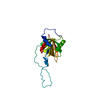 2yt1C C: citing same article ( |
|---|---|
| Similar structure data | |
| Other databases |
- Links
Links
- Assembly
Assembly
| Deposited unit | 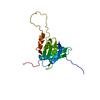
| |||||||||
|---|---|---|---|---|---|---|---|---|---|---|
| 1 |
| |||||||||
| NMR ensembles |
|
- Components
Components
| #1: Protein | Mass: 20007.119 Da / Num. of mol.: 1 / Fragment: PID domain and APP peptide Source method: isolated from a genetically manipulated source Source: (gene. exp.)  |
|---|
-Experimental details
-Experiment
| Experiment | Method: SOLUTION NMR | ||||||||||||
|---|---|---|---|---|---|---|---|---|---|---|---|---|---|
| NMR experiment |
|
- Sample preparation
Sample preparation
| Details | Contents: 1.00mM chimera sample U-15N, 13C; 20mM d-Tris-HCl; 100mM NaCl; 1mM d-DTT; 0.02% NaN3; 90% H2O, 10% D2O Solvent system: 90% H2O/10% D2O |
|---|---|
| Sample conditions | Ionic strength: 120mM / pH: 7 / Pressure: ambient / Temperature: 296 K |
-NMR measurement
| NMR spectrometer | Type: Bruker AVANCE / Manufacturer: Bruker / Model: AVANCE / Field strength: 900 MHz |
|---|
- Processing
Processing
| NMR software |
| ||||||||||||||||||||||||||||
|---|---|---|---|---|---|---|---|---|---|---|---|---|---|---|---|---|---|---|---|---|---|---|---|---|---|---|---|---|---|
| Refinement | Method: torsion angle dynamics / Software ordinal: 1 | ||||||||||||||||||||||||||||
| NMR representative | Selection criteria: lowest energy | ||||||||||||||||||||||||||||
| NMR ensemble | Conformer selection criteria: structures with the least restraint violations, target function Conformers calculated total number: 100 / Conformers submitted total number: 20 |
 Movie
Movie Controller
Controller


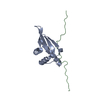
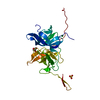
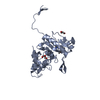
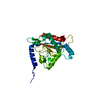

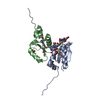
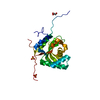
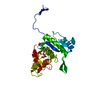
 PDBj
PDBj









 NMRPipe
NMRPipe